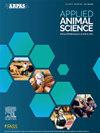Case Study: Assessment of greenhouse gas intensities on exemplary small and mid-sized US dairy farms
IF 1.5
Q3 AGRICULTURE, DAIRY & ANIMAL SCIENCE
引用次数: 0
Abstract
Objective
Our objective was to estimate greenhouse gas (GHG) intensities for 4 dairy farms representing the Northeast, Great Lakes, West, and Southeast US regions using the Farmers Assuring Responsible Management: Environmental Stewardship (FARM ES) life-cycle analysis model.
Materials and Methods
Four herds with <1,000 lactating cows, on farms selected as excellent environmental stewards, were assessed, with mean (±SD) production of 10,782 ± 2,037 kg/yr fat- and protein-corrected milk (FPCM). Data from 2021 were gathered from management software, interviews, and on-farm evaluations. Soil OM data for ≥7 yr were available on 3 farms. Emissions intensity was quantified as net CO2 equivalents (CO2e) emitted per unit of FPCM sold.
Results and Discussion
Mean (±SD) GHG emissions intensity was 0.97 ± 0.16 kg of CO2e/kg of FPCM. In terms of point sources, FARM ES attributed 42 ± 6% of the farms’ emissions to enteric methane and 28 ± 9% to manure emissions. The remaining emissions were associated with feed production and energy use. Two farms that used manure separation had an average emissions intensity 0.20 kg of CO2e/kg of FPCM less than farms that did not. Average annual soil carbon sequestration rates ranged from −0.82 to 3.52 Mg of carbon/ha, decreasing mean net GHG emissions intensity by 18% on these farms (0.81 vs. 0.99 kg of CO2e/kg of FPCM).
Implications and Applications
Management practices have wide-ranging implications for dairy farm emissions intensities, and quantifying soil carbon sequestration is key for estimating net GHG emissions for a dairy farm.
案例研究:美国中小型示范性奶牛场温室气体强度评估
我们的目标是使用农民保证负责任的管理:环境管理(FARM ES)生命周期分析模型来估计代表美国东北部、五大湖、西部和东南部地区的4个奶牛场的温室气体(GHG)强度。材料与方法选取环境管理优秀农场的4个奶牛群,共1000头泌乳奶牛,平均(±SD)产量为10,782±2,037 kg/年脂肪和蛋白质校正乳(FPCM)。2021年的数据从管理软件、访谈和农场评估中收集。3个农场有≥7年的土壤有机质数据。排放强度被量化为每单位销售的FPCM所排放的净二氧化碳当量(CO2e)。结果与讨论平均(±SD)温室气体排放强度为0.97±0.16 kg /kg FPCM。在点源方面,FARM ES将农场排放的42±6%归因于肠道甲烷,28±9%归因于粪便排放。其余的排放与饲料生产和能源使用有关。两个使用粪肥分离的农场的平均排放强度比没有使用粪肥分离的农场低0.20 kg CO2e/kg FPCM。年平均土壤固碳率为- 0.82至3.52毫克碳/公顷,这些农场的平均净温室气体排放强度降低了18%(0.81比0.99千克CO2e/千克FPCM)。影响和应用管理实践对奶牛场的排放强度有广泛的影响,量化土壤碳固存是估计奶牛场温室气体净排放量的关键。
本文章由计算机程序翻译,如有差异,请以英文原文为准。
求助全文
约1分钟内获得全文
求助全文

 求助内容:
求助内容: 应助结果提醒方式:
应助结果提醒方式:


